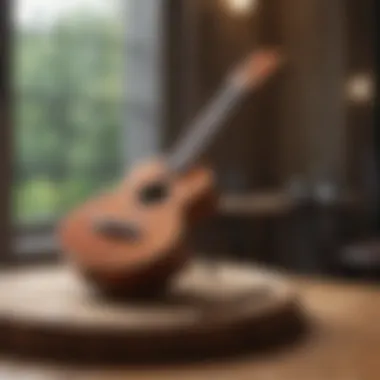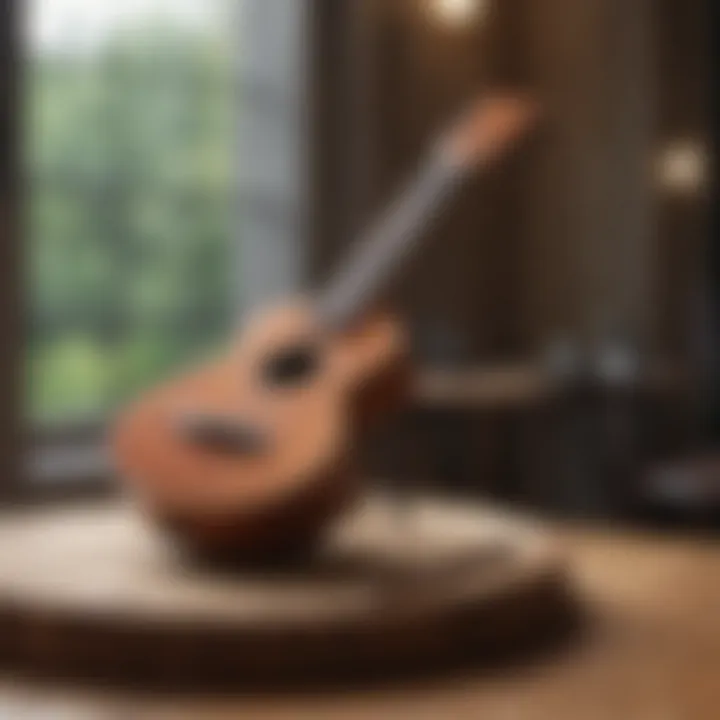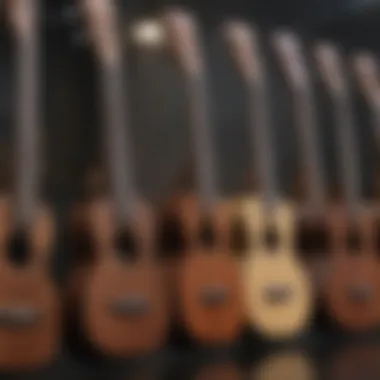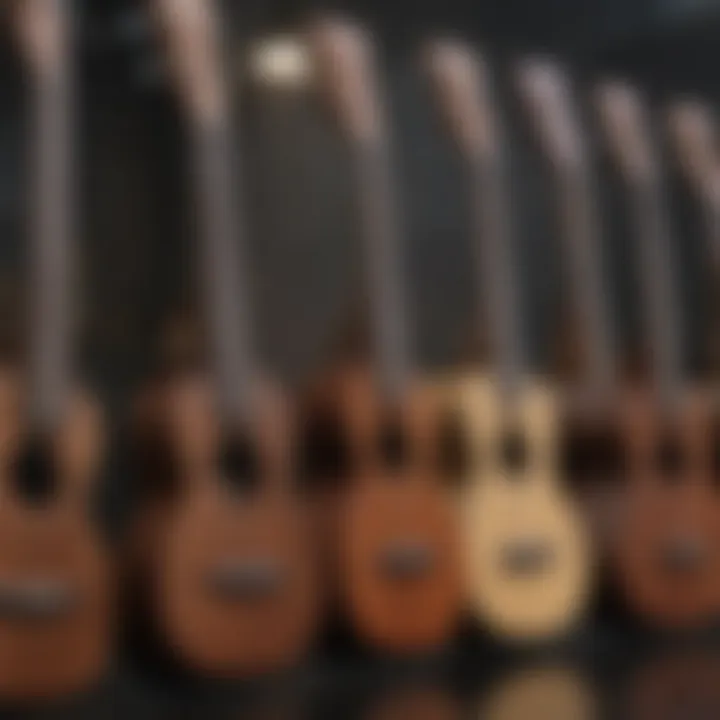Playing the Ukulele: A Beginner's Guide to Mastery


Intro
Learning to play the ukulele can quickly transform into a rewarding experience. Unlike many instruments, its simplicity invites beginners to explore music without feeling overwhelmed. This section will provide insights into essential techniques and tips that facilitate mastery over this delightful instrument. Ultimately, the ease of learning, combined with the joy of playing, makes the ukulele an attractive choice for new musicians.
Techniques and Tips
To become proficient in playing the ukulele, beginners need to focus on developing specific skills and techniques. Learning the right ways from the start is crucial.
Skill Development
Skill development begins with understanding the instrument. Familiarity with the different parts of the ukulele—such as the body, neck, and fretboard—sets a solid groundwork. Start with finger exercises to enhance dexterity. Practicing scales helps in building muscle memory, which is fundamental for progressing to more complex pieces.
Practical Techniques
There are various practical techniques to adopt when starting. First, tuning the ukulele correctly is essential for producing good sound. It can be tuned to G-C-E-A, and using a digital tuner can help ensure accuracy. Additionally, learning basic chords is vital. Some common chords include C, G, F, and Am.
Strumming patterns are an inevitable part of playing. Begin with simple downstrokes and gradually incorporate upstrokes. This variation adds rhythm to the music. Furthermore, playing along to your favorite songs or backing tracks can enhance your timing and sense of musicality.
"Playing along to music is one of the best ways to improve your skills and feel the groove of the instrument."
Common Mistakes to Avoid
Many beginners face mistakes that can hinder progress. One common mistake is not practicing regularly. Consistency is key for any musician. Avoid the temptation to play only when inspiration strikes; instead, set aside time daily.
Another common misstep is neglecting finger placement. It is easy to press strings incorrectly, leading to muted or buzzed notes. Focus on clean playing by being mindful of finger positioning. Lastly, some beginners rush through learning new skills. Take your time to master each aspect before moving on.
Gear and Equipment
Understanding the right gear is another important aspect for beginners. The right ukulele can greatly affect the learning experience.
Essential Gear for Beginners
When searching for a ukulele, consider starting with a soprano or concert model. These are typically smaller and easier to handle. Brands like Kala and Makala are popular among new players due to their affordability and quality. Don't forget to purchase a tuner, some picks, and perhaps a gig bag for transporting your instrument.
Latest Innovations and Trends
In recent years, there have been innovations in ukulele design. Some instruments now feature built-in electronics, allowing for amplification. This trend benefits those who wish to perform in larger settings. Another trend is the increase in quality of beginner models, meaning newcomers can access better sound without spending much.
Reviews and Comparisons
Numerous resources are available for comparing different ukuleles. Websites like Reddit and various music forums provide user reviews and discussions. Resources such as Wikipedia and Britannica also offer valuable information on different types of ukuleles and their history.
End
Intro to the Ukulele
The ukulele is a small yet versatile instrument that captures the attention of many aspiring musicians. Its significance in this guide stems from its approachable nature, making it an excellent starting point for beginners. Often regarded as a gateway to music, the ukulele’s cheerful sound and simple chord structures encourage new players to explore their musical expression. This introduction not only covers the basics but also highlights why this instrument is suitable for individuals at any skill level.
Origin and History of the Ukulele
The ukulele originated in the 19th century, specifically in Hawaii, and is derived from several string instruments brought over by Portuguese immigrants. The small guitar-like instrument quickly became popular among local musicians. Known as the "jumping flea" in Hawaiian, the ukulele reflects the joyful essence of Hawaiian culture through its lively musical style. Over the decades, its popularity spread beyond the Hawaiian Islands, influencing various music genres worldwide.
Today, the ukulele can be found in folk, pop, and even jazz genres. Its rich history provides a context for understanding its appeal. The instrument symbolizes creativity, cultural exchange, and a bygone era of traditional craftsmanship.
Why Choose the Ukulele?
Choosing the ukulele can be a transformative decision for anyone interested in music. This instrument has several advantages:
- Ease of Learning: The ukulele features only four strings, which are easier to manage than traditional guitars. This simplicity makes it less intimidating for beginners.
- Lightweight and Portable: Its small size allows for easy transportation, making it a great companion for road trips, beach outings, or casual jam sessions.
- Affordability: Unlike some instruments, quality ukuleles are available at various price points. This affordability makes it accessible for those just starting their musical journey.
- Community Support: A wealth of online resources, forums, and local groups exists for ukulele enthusiasts. Whether through social media platforms like Facebook or aggregating platforms like Reddit, players can connect, share tips, and encourage one another.
In summary, the ukulele is not just an instrument; it’s a way to engage with music in a fun and fulfilling manner. Its historical roots, combined with its attractive characteristics, present a compelling case for those considering taking up this delightful activity.
Understanding the Different Types of Ukuleles
Understanding the different types of ukuleles is crucial for beginners. Each type of ukulele offers unique characteristics and tonal qualities that can influence your playing experience. Knowing the distinctions helps you make informed decisions about which ukulele suits your style and preferences. It allows you to select an instrument that feels comfortable in your hands and resonates with the sound you desire. The four primary types of ukuleles are Soprano, Concert, Tenor, and Baritone. In this section, we'll explore each of these variations in detail.
Soprano Ukulele
The Soprano ukulele is the smallest of the four types. Its body length is typically around 21 inches, making it easily portable. This type produces a bright, cheerful tone. Many beginners are drawn to the Soprano because it is light and easy to handle.
Due to its size, the fretboard has a shorter scale length. As a result, the spacing between frets is closer together. This is advantageous for younger players or those with smaller hands. However, its limitations in tonal range may lead some to seek a larger model as they advance.
Key Features of the Soprano Ukulele:
- Length: About 21 inches
- Tuned to G-C-E-A
- Bright, cheerful sound
- Ideal for beginners with smaller hands
Concert Ukulele
The Concert ukulele measures around 23 inches in length. It strikes a balance between portability and playability. This type has a larger body and a slightly longer fretboard than the Soprano, offering more room for finger placement. The Concert ukulele produces a fuller sound with deeper resonance, appealing to many players.
It is also tuned to G-C-E-A, maintaining the same tuning logic as the Soprano. This means you can play the same chords on either instrument. This type is an excellent choice for those who wish to transition from beginner to intermediate playing.
Key Features of the Concert Ukulele:
- Length: About 23 inches
- Tuned to G-C-E-A
- Fuller sound than Soprano
- Good for both beginners and those advancing
Tenor Ukulele
The Tenor ukulele is a favorite among many performing musicians, measuring about 26 inches. This larger size contributes to a deeper, more resonant tone. The longer scale length allows for increased fret spacing, which can be beneficial for adult players or anyone wishing to incorporate more complex chords and techniques.
The Tenor offers a broader tonal range than the smaller models. This capability makes it suitable for strumming as well as fingerpicking. As you progress, you might find the Tenor enables you to explore different styles effectively.
Key Features of the Tenor Ukulele:
- Length: About 26 inches
- Tuned to G-C-E-A
- Deeper sound and broader tonal range
- Suitable for strumming and fingerpicking


Baritone Ukulele
The Baritone ukulele is the largest of the group, measuring about 30 inches long. The Baritone is tuned differently than the other three models, following D-G-B-E tuning. This tuning resembles the highest four strings of a guitar, which allows for a different playing style. The sizeable body produces a rich, bass sound, appealing to those looking to add depth to their music.
Due to its size and tuning, the Baritone may attract both ukulele players and guitarists alike. It can be a wonderful instrument for accompanying singing or even as a solo performance tool. While its larger size may be challenging for absolute beginners, it offers rewarding experiences for those willing to adapt.
Key Features of the Baritone Ukulele:
- Length: About 30 inches
- Tuned to D-G-B-E
- Bass-like resonance
- Appeals to both ukulele and guitar players
The choice of ukulele type significantly impacts your playing enjoyment and progress. It's worth trying different sizes to see what feels best.
Essential Gear for Beginners
Having the right gear is crucial when starting your ukulele journey. Essential gear helps you learn efficiently and adds to the overall experience of playing. Quality instruments and accessories can ease the learning process, making it more enjoyable and less frustrating. Whether you are a casual player or someone intending to dive deeper into music, having reliable equipment is vital.
Choosing Your First Ukulele
Selecting your first ukulele can be a daunting task. It influences your initial experience with the instrument. Consider factors like size, material, and sound quality. The soprano ukulele is often recommended for beginners due to its lightweight body and bright sound. It is important to hold the instrument comfortably.
Another option is the concert ukulele, which has a slightly larger body and a fuller sound. This can be beneficial if you prefer a more robust tonal quality. Ultimately, the choice should reflect your personal preferences and budget. Don’t forget to try different ukuleles before settling.
Necessary Accessories
Accessories enhance your playing experience. Each piece of gear serves a purpose that can support your growth as a musician.
Tuning Pegs
Tuning pegs are essential for maintaining your ukulele's sound. They allow you to adjust the tension of the strings, ensuring your instrument stays in tune. A key characteristic of tuning pegs is their stability. A good tuning peg holds the string well and resists slipping. Many beginners prefer geared tuning pegs since they provide finer adjustments. This feature helps newcomers find the right pitch without excessive effort. However, cheaper tuners might slip out of tune frequently.
Capo
A capo is another important accessory for beginners. It allows you to change the key of a song quickly without changing finger positions. This is particularly beneficial for beginners who may struggle with finger positioning while playing different chords. It can expand your range and enable you to play along with various songs easily. It is simple to use, making it a practical tool for all skill levels. However, using a capo too frequently can hinder the development of your chord skills, as it can allow you to avoid learning new fingerings.
Straps
Using a strap can vastly improve playing comfort and stability, especially during longer practices. A strap holds the ukulele securely, enabling you to stand while playing. This can have a positive impact on your posture and technique. Look for straps that are adjustable and made from comfortable materials, as this can prevent neck or back discomfort. However, if your ukulele does not have strap buttons, you might need additional attachments.
Covers
Protecting your ukulele should not be an afterthought. A cover keeps your instrument safe from dust and scratches when not in use. It can also protect against minor bumps during travel. Look for covers with padding, as they provide extra protection. Some covers are designed to be portable, making it easier to bring your ukulele to lessons or gatherings. However, if the cover fits too tightly, it could be difficult to take the instrument out.
Maintaining Your Ukulele
Proper maintenance of your ukulele is essential for its longevity and sound quality. Regularly clean the body and strings to prevent buildup that can affect tone. Store your instrument in a suitable environment to avoid damage from humidity changes. A little care goes a long way in preserving your instrument's performance.
Learning to Tune Your Ukulele
Tuning your ukulele is an essential skill that every beginner should master. A well-tuned instrument not only sounds better, but it also enhances the learning experience. When playing with others or even to yourself, proper tuning creates a more harmonious and rewarding musical experience. A ukulele that is out of tune can be frustrating and may lead to a lack of motivation to practice.
Benefits of Learning to Tune Your Ukulele:
- Improved Sound Quality: A tuned ukulele produces clearer notes.
- Easier Learning of Chords: Chords become more recognizable and sound more musical when in tune.
- Better Playing Alongside Others: If you're jamming with friends or participating in group lessons, being in tune is crucial.
- Building Confidence: Regularly tuning your instrument develops your ear for music, improving your skills over time.
Considering these aspects, tuning is a basic yet most effective technique for developing a lifelong relationship with music.
Standard Tuning Explained
Standard tuning for a ukulele is G-C-E-A, from the top string to the bottom string. This means:
- The top string (G) is the first string. It is the highest note.
- The second string (C) is tuned to a C note. It is the lowest note in the standard tuning.
- The third string (E) is tuned to an E note.
- The bottom string (A) is tuned to an A note.
To make tuning easier, here are some guidelines:
- Use a reference pitch, which can come from various sources.
- Online tuners are readily available and can be very helpful for beginners.
- Plucking each string gently helps you find the right pitch.
Using a Tuner vs. Tuning by Ear
When it comes to tuning, one common question arises: Should you use a tuner or tune by ear? Both methods have their merits.
Using a Tuner:
- Convenience: Digital tuners are straightforward and can ensure accuracy.
- Speed: They speed up the process, which is especially helpful for beginners.
- Consistency: Regular use helps develop an understanding of pitch.
Tuning by Ear:
- Skill Development: This method nurtures your musical ear, which enhances your playing overall.
- Focus on Pitch: It encourages you to listen carefully to how the strings relate to each other.
- Connection to Music: Engaging with sound creates a stronger attachment to the music you play.
Basic Chords for Beginners
Understanding basic chords is essential for every ukulele player, especially beginners looking to unlock the instrument's potential. Chords are the building blocks of music; they form the foundation upon which melodies are constructed. Without a solid grasp of these initial chords, your progress will be limited. Beginners will find that mastering just a few basic chords enables them to play countless songs, resulting in quick gratification and increased motivation.
Moreover, focusing on basic chords allows new players to develop finger strength and dexterity. This, in turn, makes transitions between chords smoother and more fluid. It is important to remember that practicing these chords effectively can significantly influence your overall confidence while playing.
Common Open Chords
Major
C Major is often the first chord taught to ukulele beginners. It is constructed from three simple notes: C, E, and G. The key characteristic of C Major is its bright, harmonious sound that resonates well, making it accessible for any newbie. It is a beneficial choice for beginners as it requires only one finger to play; you press down on the third fret of the A string while leaving others open.
The unique feature of C Major lies in its simplicity. This can be an advantage, especially at the start of your learning journey. However, some may find its straightforwardness less exciting as they advance in skill.
G Major
G Major is another fundamental chord that offers a sense of uplifting character. It comprises three notes: G, B, and D. The key aspect of G Major is its fuller, richer sound compared to other basic chords. Many popular songs utilize it, making it a favored choice among beginners.
G Major, however, requires more finger placement as it uses three fingers. This can be challenging for some, but mastering G Major grants more versatility in song selection, establishing it as an important chord to learn early on.


A Minor
A Minor introduces a slightly different emotional quality to music. It consists of the notes A, C, and E. The key characteristic of A Minor is its more melancholic tone, which can add depth and variety to songs. This chord is fairly easy to play; you only need to press down on the second fret of the G string.
The unique aspect of A Minor is its contrast to major chords. It helps beginners understand the difference in feeling that chords can evoke. However, its slightly diminished sound may not be first choice for some players focusing on upbeat songs.
E Minor
E Minor creates a moody, introspective vibe. It is made up of the notes E, G, and B. One of its key features is that it provides a transition between happy and sad sounds, allowing for emotional variation in playing. E Minor may require more finger strength as it demands pressing down on the second fret of the A and D strings.
The advantage of learning E Minor is its application in various music genres, including folk and rock. Beginners may find it challenging, yet its inclusion in their repertoire enhances overall versatility in playing.
Practicing Chord Transitions
Practicing smooth transitions between chords is crucial for any ukulele player. Effective transitions facilitate continuous play, making music sound more polished. Setting aside dedicated practice time to focus solely on changing between chords will greatly improve your overall skill. This aspect of practice allows beginners to build muscle memory, leading to a more enjoyable playing experience.
"Consistent practice is the key to progressing and enjoying your musical journey."
Start by slowly switching between chords, ensuring that each chord sounds clear before increasing speed. You can create a routine that includes switching between the chords C Major, G Major, A Minor, and E Minor. Gradually, as comfort increases, aim for quicker transitions.
Basic Strumming Patterns
Basic strumming patterns are fundamental for any beginner looking to play the ukulele effectively. They form the backbone of playing songs, creating melody, and providing rhythm. Understanding these patterns is crucial in mastering the instrument. As with any musical endeavor, a strong sense of rhythm will elevate your sound, giving it depth and character.
Developing good strumming techniques can significantly enhance your playing style. Additionally, incorporating various patterns can keep your performance interesting and dynamic. Some patterns may suit specific genres better than others. Hence, experimenting is encouraged.
Understanding Rhythm
Rhythm is the pulse of music. It dictates how we feel the flow of a song. In strumming, having a clear understanding of rhythm is essential. Practicing rhythm helps in timing and synchronization with other musicians, as well as reinforcing chord changes. Breaking down songs into smaller rhythmic components makes them easier to grasp.
Beginners should start with simple rhythms to build confidence. Developing an internal sense of timing will smoothen the learning process. A metronome can also be a helpful tool, aiding in keeping the beats steady. Gradually, as the player becomes more comfortable, they can start to add more complexity to their rhythms.
Simple Strumming Techniques
Downstrokes
Downstrokes refer to the action of strumming the strings from the top down towards the bottom of the ukulele. This technique is straightforward and is the most common starting point for beginners. The primary characteristic of downstrokes is their simplicity; they provide a strong and steady rhythm that lays a solid foundation for any piece.
One major advantage of downstrokes is their versatility. They are beneficial for beginners as they require less coordination compared to more complex techniques. Downstrokes can easily be integrated into various styles and genres, making them a popular choice in ukulele play.
However, continuously using only downstrokes can sound monotonous. To prevent this, players should eventually balance their practice with other strumming techniques.
Upstrokes
Upstrokes involve strumming the strings from the bottom up towards the top of the ukulele. This technique complements downstrokes perfectly, creating a dynamic strumming pattern. The key characteristic of upstrokes is their ability to add texture and variation to the music. They often create a lighter sound, filling in the gaps left by downstrokes.
Upstrokes are popular among ukulele players as they contribute to more intricate strumming patterns. They enhance the rhythmic complexity of a piece and can make a song feel more lively. However, mastering the coordination between downstrokes and upstrokes may take practice. Beginners might initially find upstrokes challenging.
Understanding the basics of strumming patterns opens new possibilities for creativity and musical expression.
For further exploration, consider resources like or to join discussions on techniques and patterns.
Simple Songs to Start Playing
Playing songs on the ukulele is one of the most rewarding experiences for beginners. Learning simple songs provides an excellent way to practice and improve your skills. Simple songs often incorporate basic chords and strumming patterns, which makes them suitable for those who are just starting out. Playing familiar tunes not only boosts confidence but also enhances understanding of timing and rhythm. It helps create a strong foundation for more complex pieces in the future.
Beginner-Friendly Songs
When it comes to choosing songs for beginners, there are several factors to consider. The ideal song should be easy to play and have a catchy melody. Here are some popular options:
- "You Are My Sunshine"
This classic song uses simple chords like C, F, and G. It’s a great tune for beginners to practice chord transitions. - "Twinkle, Twinkle, Little Star"
This children’s song is well known and employs basic chords that make it easy to learn. - "Happy Birthday"
A must-know song for every musician! It’s simple and perfect for celebrations. - "Row, Row, Row Your Boat"
This song is not only easy to play but also fun to sing. - "Let It Be" by The Beatles
This timeless piece includes a few simple chords and is immensely satisfying to play.
These songs are excellent starting points because they help reinforce your understanding of chords and melodies, making you more comfortable with the instrument.
Using Online Resources for Learning Songs
The internet is a treasure trove of resources for learning ukulele songs. It offers a wealth of tutorials, sheet music, and tabs to aid your practice. Here are some platforms that can help:
- YouTube
Many channels are dedicated to teaching ukulele. You can find tutorials that break down how to play specific songs step-by-step. - Ukulele Underground
This site offers lessons, forums, and a library of sheet music for many popular songs. - Ultimate Guitar
Here, you can find a large collection of tabs and chords for numerous songs across genres. - Reddit
The ukulele community on Reddit can provide recommendations for songs and personal experiences that can aid in the learning process.
Engaging with these online resources not only aids in learning songs but also connects you with a community of fellow ukulele enthusiasts. This can provide the motivation needed to keep progressing.
Overall, starting with simple songs is a crucial step for ukulele beginners. It not only makes the learning process enjoyable but also lays the groundwork for advanced technique development in the future.
"The shortest journey starts with a single note."
Embrace these early victories in your ukulele journey, and remember to enjoy the process of learning and playing.
Practice Strategies for Beginners
Embarking on the journey of learning the ukulele requires structured practice strategies. These strategies not only enhance skills but also ensure a more fulfilling musical experience. For a beginner, the importance of effective practice cannot be overstated. Structured practice leads to measurable progress, enhances skill retention, and fosters a deeper connection with the instrument.
Creating a plan to practice intentionally makes the learning process smoother. Without a clear intent, progress might stagnate, leading to frustration. A well-thought-out practice strategy incorporates various elements like time management, technique focus, and creativity. This approach helps in maintaining motivation and breaking the monotony of routine.
Setting Realistic Goals
Setting realistic goals is a fundamental step in any learning process, particularly for beginners. When first starting with the ukulele, it’s essential to establish achievable objectives. Goals should be specific, measurable, attainable, relevant, and time-bound. For example, a beginner might aim to learn three simple chords within the first week.
Achieving small goals contributes to a sense of accomplishment. It also builds confidence in one's ability to progress further. Rather than overwhelming oneself with complex songs or techniques, starting with simple tasks can pave the way for more advanced skills later on.
In addition to musical goals, it's important also to set emotional and engagement goals. Give yourself a target of playing for a short period every day, even if it's just ten minutes. Tracking progress over time can help in recognizing improvements more clearly.
Effective Practice Routines
An effective practice routine could be the difference between quickly mastering the ukulele and prolonging the learning process. Beginners should establish a consistent practice schedule. Regular, focused sessions are more valuable than sporadic, lengthy ones.


Here are a few effective elements to include in a practice routine:
- Warm-up Exercises: Start with simple scales or finger exercises.
- Chords Practice: Dedicate time to switch between different chords.
- Strumming Patterns: Work on various strumming patterns to add rhythm to your playing.
- Song Practice: Select simple songs that incorporate the skills you are currently developing.
- Cool Down: End sessions with an enjoyable song or exercise to close positively.
Ultimately, the key to effective practice routines is balance. Too much repetition can lead to burnout while too little practice can hinder progress. Adjust timing and focus based on personal comfort and engagement levels. Over time, these strategies will cultivate a solid foundation for playing the ukulele and discovering its vast musical potentials.
Overcoming Challenges in Learning
Learning to play the ukulele can be a rewarding experience, but it often comes with its own set of challenges. Addressing these challenges is essential for beginners to maintain progress and develop a love for the instrument. Understanding common issues, developing strategies to overcome them, and staying motivated are key elements to ensure a fruitful learning process. This section provides insights into the difficulties that may arise and offers effective ways to handle them, ensuring that newcomers remain engaged and enthusiastic.
Common Pitfalls and How to Avoid Them
One of the main obstacles for beginner ukulele players is the initial difficulty in understanding basic chords and strumming patterns. This can lead to frustration and a feeling of inadequacy. To mitigate this, beginners should
- Start Slow: Begin by practicing one chord at a time. This way, you build confidence before moving on to more complex chords.
- Use Visual Aids: Chord charts and videos can be tremendously helpful. Many online resources provide visual demonstrations that clarify finger placements and transitions.
- Practice Regularly: Setting a consistent practice schedule can help cement skills over time. Even a few minutes every day can yield significant progress compared to longer, infrequent sessions.
Another common pitfall is the temptation to compare oneself to more experienced players. This can affect self-esteem and motivation. It's crucial to focus on one's own journey. Each player learns at their own pace.
"Remember, the joy of music lies in the journey, not just the destination."
Staying Motivated
Maintaining motivation is vital for any learning process. The ukulele, with its playful sound and approachable nature, can inspire joy and creativity. Here are some strategies to stay motivated:
- Set Achievable Goals: Break your learning into manageable goals. For instance, aim to learn a new chord each week or master a simple song by the end of the month. This will give you a sense of accomplishment.
- Join a Community: Engaging with fellow ukulele enthusiasts can provide support and encouragement. Look for local groups or online forums, such as those on Reddit or Facebook, where you can share experiences and learn together.
- Track Your Progress: Keep a journal of your practice sessions and achievements. Reflecting on growth can be a powerful motivator.
- Explore Different Styles: Try playing different genres of music. Experimenting with styles like pop, folk, or Hawaiian can keep practice fresh and enjoyable.
By actively recognizing challenges and seeking solutions, beginner ukulele players can navigate the initial hurdles with more ease. This proactive approach fosters a deeper connection to the music and enhances the overall experience of learning the ukulele.
Connecting with the Ukulele Community
Engaging with the ukulele community enriches the learning experience significantly. It's not just about playing notes and chords; it’s also about sharing the passion for music and forming connections with other musicians. Whether you are a novice or have some experience, joining a community can provide support, motivation, and even new friendships.
A strong community gives you the opportunity to receive feedback on your playing, find collaborators for music projects, and access collective knowledge. Learning from others’ experiences can also provide insights that might not be covered in standard tutorials. It encourages regular practice, as you may feel more accountable to a group. Lastly, being part of a community can enhance enjoyment, as playing music often is more fulfilling when shared with others.
Finding Local Groups and Classes
Locating local groups or classes dedicated to ukulele playing can be a beneficial move. Many cities have community centers or music stores that offer regular classes. These classes often cater to various skill levels, ensuring that every participant finds a place to thrive.
Additionally, local music shops often host meet-ups or jam sessions. Joining these events allows you to connect with other players in person, share tips, and advance your skills together. Engaging with fellow ukulele enthusiasts helps build your confidence and even leads to opportunities for performances.
Some specific avenues to explore include:
- Community Centers: Look for classes or groups that meet regularly in your area.
- Music Stores: Many have bulletin boards where local musicians post information about groups.
- Libraries: Some libraries offer music programs, including ukulele classes.
Online Forums and Social Media
If local options seem limited, the internet offers vast resources for connecting with other ukulele players worldwide. Online platforms can provide an abundance of information, support, and motivation.
Forums like Reddit have dedicated spaces for ukulele enthusiasts, where people share experiences, tips, and tutorials. Participating in these discussions can lead to valuable advice or solutions to common problems faced by beginners. On platforms like Facebook, there are various groups that welcome members with all skill levels, fostering interaction and the sharing of experiences.
Here are some tips for engaging in online forums:
- Ask Questions: Don’t hesitate to seek advice about playing techniques or gear.
- Share Progress: Post videos or updates on your learning journey to receive feedback.
- Participate Actively: Engage with other users’ posts to create a sense of community.
Through both local engagement and online platforms, connecting with the ukulele community can tremendously enhance your learning journey, making it more enjoyable and fulfilling.
Resources for Further Learning
In any musical journey, resources play a pivotal role in enhancing the learning experience. For beginners learning to play the ukulele, having access to various materials can significantly impact skill development and reinforce understanding. Resources can provide structured guidance, illustrations of techniques, and diverse music styles. In this segment, we will explore three primary types of resources: books and tutorials, YouTube channels and video lessons, and mobile apps for ukulele learning. Each has its own benefits and can complement your learning style effectively.
Books and Tutorials
Books serve as timeless guides, offering comprehensive insights into playing the ukulele. They can take a novice through the basics to more advanced concepts seamlessly. Often rich with illustrations, these texts clarify chord shapes, strumming patterns, and even song structures. Here are some recommended aspects of books you should consider:
- Structured Learning: Books usually have a clear progression, starting from basics and gradually moving to complex topics.
- In-depth Explanations: They provide detailed explanations of technical concepts that may be quickly skimmed over in videos or shorter tutorials.
- Self-Paced: You can learn at your own pace, revisiting complex sections as many times as needed.
Several notable books and tutorial series are available that aid in learning. Many of these resources can be found at local libraries, bookstores, or online platforms to ensure accessibility.
YouTube Channels and Video Lessons
Visual learners will find YouTube channels incredibly beneficial. Video lessons allow for real-time demonstrations of techniques and concepts that text cannot capture as clearly. Here are features that make YouTube a valuable resource:
- Live Demonstrations: Viewers can witness how chords and strumming patterns are executed, providing a clearer context.
- Community Engagement: Many channels encourage viewer interaction through comments, allowing learners to ask questions or seek clarifications.
- Variety of Content: A vast array of instructors means different teaching styles and genres, catering to varied preferences.
It’s advisable to look for reputable channels that maintain high teaching standards. Subscrbing to these channels can keep you updated on new lessons and techniques.
Mobile Apps for Ukulele Learning
Mobile applications have become pivotal for learners seeking flexibility in their practice. These apps often provide a mix of features suited for on-the-go learning. Consider the following benefits:
- Convenience: Learners can practice anytime, anywhere, using their mobile device.
- Interactive Learning: Many apps offer interactive lessons, games, and quizzes to reinforce learning through engagement.
- Progress Tracking: Many applications include features to track your progress, aiding motivation and goal-setting.
Some popular apps in the ukulele community include Yousician and Ukulele Tuner. These apps can enhance practice and allow users to explore new songs and techniques.
In summary, utilizing a combination of books, video lessons, and mobile apps can lead to a richer learning experience for ukulele beginners. Each type of resource complements the others, creating a well-rounded approach to mastering the instrument. By taking advantage of these resources, students can cultivate their skills effectively and develop a lifelong passion for music.
Ending
As this article draws to a close, it is vital to reflect on the journey of learning the ukulele. Each section provided important insights and practical advice aimed at beginners. Understanding the types of ukuleles helps in making informed choices about your instrument. Tuning methods establish a solid foundation for sound quality, while grasping basic chords allows for the immediate start of music-making. Strumming patterns and song selection further enrich the learning experience.
Learning the ukulele is not just about picking up an instrument. It is about freeing creativity and connecting with a music-loving community. Practicing effectively and overcoming challenges can maintain motivation. Connecting with others, whether locally or online, can enhance your experience. These interactions often bring new perspectives and inspire continual growth in skill.
In summary, the process of learning the ukulele integrates patience, determination, and joy. Embracing this journey means that every chord played and song learned is a step towards becoming a confident musician. Playing the ukulele opens up a world of musical possibilities and personal fulfillment.
The ukulele is not merely an instrument; it is a gateway to creativity and connection.
The Journey Ahead
Looking forward, the pathway of learning the ukulele remains exciting. No matter where you start, there is always room to grow. Setting personal goals can guide your practice sessions. Perhaps you want to learn specific songs or master a particular style. These goals should be tailored to your interests.
Consider exploring various genres of music. Each style can introduce new techniques and chords. The more diverse your practice, the broader your skill set will become. Additionally, engaging with advanced players can offer valuable insights. Lessons from experienced musicians often illuminate paths not immediately evident.
Furthermore, the resources mentioned earlier—books, video lessons, and community platforms—should not be overlooked. These materials are crucial for ongoing education.







